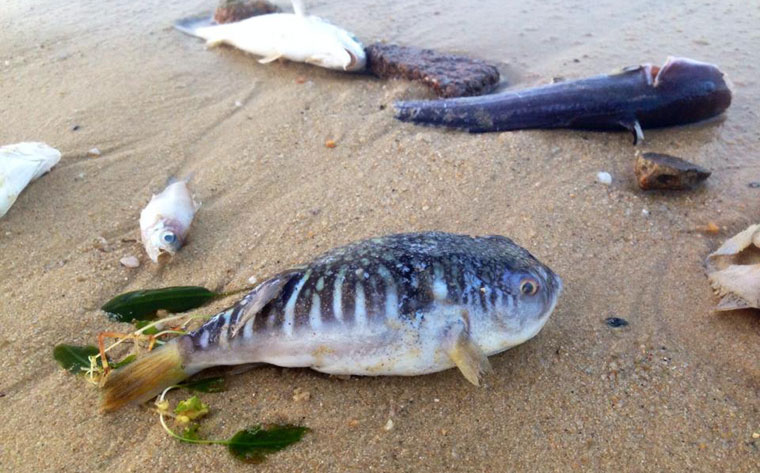Scenes of death littered the sandy beaches at western Pasir Ris on Feb. 28, 2015, as thousands of fishes and marine creatures washed up dead on the shore.



Judging by the state of some of the fishes washed up and dried out, it is estimated they might have been brought to the beach by the high tide from anywhere between 12 and 24 hours before they were examined on Saturday afternoon.
Photos of the mass death have been posted on Facebook with speculation as to what happened being blogged about on Wild Shores of Singapore, but there are still no definite answers as to what caused the deaths, even as the Agri-Food and Veterinary Authority (AVA) has started investigating fish deaths as early as one week ago.
However, what is known is that something similar happened around the same time last year, where thousands of fishes in the eastern part of Singapore and Pulau Ubin washed up dead.
It was explained last year that the cloudless dry weather caused temperatures in the body of water in the narrow Johor Straits to rise, causing algae to bloom, which made the water environment oxygen-deficient.
From Wild Shores of Singapore:
What is killing the fishes at Pasir Ris?
Around the same time last year, there were mass fish deaths at the Eastern fish farms located in the waters between Pasir Ris and Pulau Ubin. Conditions now are rather similar to last year: cloudless dry weather leading to higher water temperatures in the narrow Johor Straits.
Higher water temperatures allow tiny organisms in the water to reproduce more rapidly. These include algae which consequently 'bloom' or rapidly increase in numbers. Like other living organisms, these absorb oxygen. The population explosion thus leads to a rapid reduction in dissolved oxygen in the water.
As populations of oxygen-sucking organisms explode, they create 'dead zones' in the water lacking oxygen. These zones kill immobile or slow-moving animals. Animals that swim into such a zone can succumb quickly and die too.
The blog post also mentioned that this theory has been corroborated by the first-hand observation of least one person who was conducting a kayaking lesson over this weekend at Pasir Ris, who said that the water temperature felt higher than usual.
Other plausible-sounding theories about what caused the fishes to die en masse include the dumping of dead fishes by unscrupulous fish farms -- as quite a number of the fishes found on the shore were of the same size and breed -- as well as the sudden change in water conditions that could have been a result of unusual discharge which was noticed last year or excessive littering in Pasir Ris.
The clean-up efforts are underway, although they were met with some difficulty as dead fishes kept washing up on the beach.
The public is advised to stay clear of areas where the dead fishes are to be found, but for volunteers who are monitoring the situation, you can reach out to Wild Shores of Singapore.
Related articles:
Crazy weather patterns in S’pore causing unusual mass blooming of flowers
Autumn is coming to S’pore as trees turn red and yellow
All photos via Sean Yap Pasir Ris Beach mass deaths Feb 2015 Facebook
If you like what you read, follow us on Facebook and Twitter to get the latest updates.
If you like what you read, follow us on Facebook, Instagram, Twitter and Telegram to get the latest updates.
